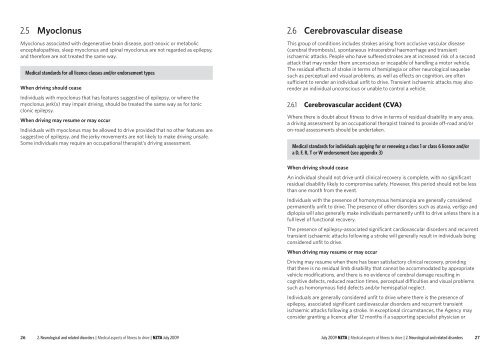Medical aspects of fitness to drive a guide for medical practitioners
Medical aspects of fitness to drive a guide for medical practitioners
Medical aspects of fitness to drive a guide for medical practitioners
You also want an ePaper? Increase the reach of your titles
YUMPU automatically turns print PDFs into web optimized ePapers that Google loves.
2.5 Myoclonus<br />
Myoclonus associated with degenerative brain disease, post‐anoxic or metabolic<br />
encephalopathies, sleep myoclonus and spinal myoclonus are not regarded as epilepsy,<br />
and there<strong>for</strong>e are not treated the same way.<br />
<strong>Medical</strong> standards <strong>for</strong> all licence classes and/or endorsement types<br />
When driving should cease<br />
Individuals with myoclonus that has features suggestive <strong>of</strong> epilepsy, or where the<br />
myoclonus jerk(s) may impair driving, should be treated the same way as <strong>for</strong> <strong>to</strong>nic<br />
clonic epilepsy.<br />
When driving may resume or may occur<br />
Individuals with myoclonus may be allowed <strong>to</strong> <strong>drive</strong> provided that no other features are<br />
suggestive <strong>of</strong> epilepsy, and the jerky movements are not likely <strong>to</strong> make driving unsafe.<br />
Some individuals may require an occupational therapist’s driving assessment.<br />
2.6 Cerebrovascular disease<br />
This group <strong>of</strong> conditions includes strokes arising from occlusive vascular disease<br />
(cerebral thrombosis), spontaneous intracerebral haemorrhage and transient<br />
ischaemic attacks. People who have suffered strokes are at increased risk <strong>of</strong> a second<br />
attack that may render them unconscious or incapable <strong>of</strong> handling a mo<strong>to</strong>r vehicle.<br />
The residual effects <strong>of</strong> stroke in terms <strong>of</strong> hemiplegia or other neurological sequelae<br />
such as perceptual and visual problems, as well as effects on cognition, are <strong>of</strong>ten<br />
sufficient <strong>to</strong> render an individual unfit <strong>to</strong> <strong>drive</strong>. Transient ischaemic attacks may also<br />
render an individual unconscious or unable <strong>to</strong> control a vehicle.<br />
2.6.1<br />
Cerebrovascular accident (CVA)<br />
Where there is doubt about <strong>fitness</strong> <strong>to</strong> <strong>drive</strong> in terms <strong>of</strong> residual disability in any area,<br />
a driving assessment by an occupational therapist trained <strong>to</strong> provide <strong>of</strong>f‐road and/or<br />
on‐road assessments should be undertaken.<br />
<strong>Medical</strong> standards <strong>for</strong> individuals applying <strong>for</strong> or renewing a class 1 or class 6 licence and/or<br />
a D, F, R, T or W endorsement (see appendix 3)<br />
When driving should cease<br />
An individual should not <strong>drive</strong> until clinical recovery is complete, with no significant<br />
residual disability likely <strong>to</strong> compromise safety. However, this period should not be less<br />
than one month from the event.<br />
Individuals with the presence <strong>of</strong> homonymous hemianopia are generally considered<br />
permanently unfit <strong>to</strong> <strong>drive</strong>. The presence <strong>of</strong> other disorders such as ataxia, vertigo and<br />
diplopia will also generally make individuals permanently unfit <strong>to</strong> <strong>drive</strong> unless there is a<br />
full level <strong>of</strong> functional recovery.<br />
The presence <strong>of</strong> epilepsy‐associated significant cardiovascular disorders and recurrent<br />
transient ischaemic attacks following a stroke will generally result in individuals being<br />
considered unfit <strong>to</strong> <strong>drive</strong>.<br />
When driving may resume or may occur<br />
Driving may resume when there has been satisfac<strong>to</strong>ry clinical recovery, providing<br />
that there is no residual limb disability that cannot be accommodated by appropriate<br />
vehicle modifications, and there is no evidence <strong>of</strong> cerebral damage resulting in<br />
cognitive defects, reduced reaction times, perceptual difficulties and visual problems<br />
such as homonymous field defects and/or hemispatial neglect.<br />
Individuals are generally considered unfit <strong>to</strong> <strong>drive</strong> where there is the presence <strong>of</strong><br />
epilepsy, associated significant cardiovascular disorders and recurrent transient<br />
ischaemic attacks following a stroke. In exceptional circumstances, the Agency may<br />
consider granting a licence after 12 months if a supporting specialist physician or<br />
26 2. Neurological and related disorders | <strong>Medical</strong> <strong>aspects</strong> <strong>of</strong> <strong>fitness</strong> <strong>to</strong> <strong>drive</strong> | NZTA July 2009<br />
July 2009 NZTA | <strong>Medical</strong> <strong>aspects</strong> <strong>of</strong> <strong>fitness</strong> <strong>to</strong> <strong>drive</strong> | 2. Neurological and related disorders 27
















